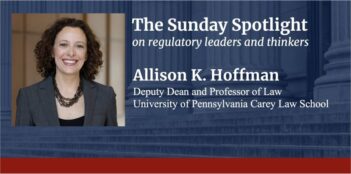
A theory of “balanced federalism” may advance the federalism debate over health care reform.
In just a matter of days, the Supreme Court will decide what some believe will be among the most important cases in American history.
In the “Obamacare” cases, the Court will consider whether the Affordable Care Act (ACA) exceeds the boundaries of federal authority under the various provisions of the Constitution that establish the relationship between local and national governance. Its response will determine the fate of Congress’s efforts to grapple with the nation’s health care crisis, and perhaps other legislative responses to wicked regulatory problems like climate governance or education policy. Whichever way the gavel falls, the decisions will likely impact the upcoming presidential and congressional elections, and some argue that they may significantly alter public faith in the Court itself. But from a constitutional perspective, the decisions will be important because they will speak directly to the interpretive problems of federalism that have ensnared the architects, practitioners, and scholars of American governance since the nation’s first days.
Federalism is the Constitution’s mechanism for dividing authority between the national and local levels. In a nutshell, federalism assesses which kinds of policy questions should be decided nationally—yielding the same answer throughout the country—and which should be decided locally—enabling different answers in different states. Accordingly, the basic inquiry in all federalism controversies is always the same: who should get to decide? Is it the state or federal government that should make these kinds of health policy choices? And just as important, especially in the case of health care reform, is who gets to answer that question—the political branches or the judiciary? Should the Court defer to Congress’s choices in enacting the ACA, or is it the responsibility of the Court to substitute its own judgment for the legislature’s on such matters?
The reason federalism questions have become so complicated—and so controversial—is that the Constitution itself, beautiful as we may think it, usually does not resolve them. Indeed, the problem that pervades all federalism controversies is that the Constitution mandates but incompletely describes our federal system, in a way that forces those implementing it to rely on some external theory about the purpose of federalism and how it should operate when applying its vague directives to actual controversies. Unsurprisingly, there are multiple competing theories, all consistent with those directives but pushing us in different directions.
Two theories have particularly influenced the Court’s notoriously vacillating federalism jurisprudence. The “dual federalism” approach prefers stricter separation between proper spheres of state and federal power, policed by judicially enforced constraints that trump legislative determinations. Dual federalism’s proponents see federalism as a zero-sum game, in which any expansion of federal reach comes at the direct expense of state reach, and vice versa. “Cooperative federalism” rejects the zero-sum model and tolerates greater jurisdictional overlap. It urges judicial deference to federalism-sensitive policymaking because the elected branches know best, and because “political safeguards” for federalism are already embedded in constitutional design, given that national representatives are elected at the state level.
The battle between these classic federalism contenders was on full display during the ACA oral arguments. For example, the question most vexing Justice Kennedy about the individual mandate was that of federal limits. If the federal government can mandate that everyone buy health insurance, he asked, then what can’t it do? Does affirming a mandate like this one effectively eviscerate all determinable limits of federal power under the Commerce Clause, or any other? Could Congress next order us to eat broccoli, for all the same reasons it can require us to buy health insurance? In this respect, he voiced the dual federalism perspective, suggesting that judicial safeguards might be necessary to police the perilous boundaries of federal authority. (However, this analysis begs the question: Were it a state government ordering us to eat broccoli, would that be okay? )
Donald Verrilli, the Solicitor General defending the ACA, replied from the cooperative federalism perspective that the effective limits on federal power were located in the democratic process itself. He argued that nobody could seriously imagine a congressional mandate to eat broccoli because, to the extent Americans believe it unreasonable, they would not elect representatives who would enact it (and they would replace any who did). He answered with the political-safeguards refrain that Congress reliably makes these difficult choices, which are more amenable to legislative deliberation than judicial review. (This perspective begs the counter-question: So long as the Congress that orders us to eat broccoli is duly elected, is federalism satisfied?)
This moment of Supreme Court dialogue, reiterating a conversation hallowed by centuries of repetition, reveals the rabbit-hole in which federalism debates have languished for too long—stuck between alternatives of jurisdictional separation or overlap, and judicial or legislative hegemony. But neither approach satisfactorily balances the roles of the different branches, and neither gives us the tools we really need to evaluate a theoretical broccoli law (or any other). A better approach to resolving federalism controversies like Obamacare frames the “who decides” question as an examination of how the challenged governance relates to the values that underlie American federalism in the first place, and who can best evaluate that in which circumstances.
Americans invented federalism to help us actualize a set of good-governance goals in operation of the new union. We created checks and balances between local and national power to protect individuals against governmental overreaching or abdication on either side. Federalism fosters local autonomy and interjurisdictional competition, and we hope it will promote governmental accountability to enhance democratic participation throughout the jurisdictional spectrum. Federalism also facilitates the problem-solving synergies that arise between the separate strengths of local and national governance for dealing with different parts of interjurisdictional problems. On balance, if the governance in question advances these values, then it is consistent with the Constitution’s federalism directives. If it detracts from them, then we have a problem.
The trick, of course, is that while all of these values are independently good things, they are nevertheless suspended in tension with one another, such that you cannot always satisfy all of them at the same time. Sometimes local autonomy pulls in the opposite direction from checks-and-balances, which can alternatively frustrate problem-solving synergy. These tensions expose the values “tug of war” within federalism, highlighting the inevitable tradeoffs in interjurisdictional governance that makes federalism so difficult. Moreover, they suggest that the most robust approach for resolving federalism controversies should be tethered to considering how challenged governance fails or succeeds in advancing these fundamental values.
And that’s just what the Court should be doing in analyzing the ACA. Rather than asking whether the law violates some abstract limit on federal power, the Court should ask whether the trade-offs against some federalism values are justified in service to others.
The states challenging the federal statute submit that the law compromises local autonomy too much, while the federal government maintains that the need for collective-action problem-solving justifies any intrusion, which is limited by the flexibility the law confers on states to create alternative programs and to opt out entirely by declining federal funds. The plaintiffs argue that the individual mandate compromises the very individual rights that checks and balances are designed to protect, while the defendants protest that there is no recognized right to not buy health insurance, especially when the failure to do so externalizes harms to other individuals. They might further argue that both checks and synergy values are served by the use of a regulatory partnership approach to health reform rather than full federal preemption. And so on.
In a new book, Federalism and the Tug of War Within, I offer a theory of “balanced federalism” to facilitate these foundational inquiries. Federalism analysis tethered to underlying constitutional values would help ensure governance that best advances them, and it would defuse the frequent constitutional grandstanding in which federalism is strategically deployed to mask substantive policy disagreements. In the end, the question should not be whether only the state or also the federal government can make us eat broccoli. Instead, it is whether there are constitutionally compelling reasons for either to do so. Either way, one thing remains clear: No matter what the Court decides this month, we are sure to be talking about it for a very long time.




